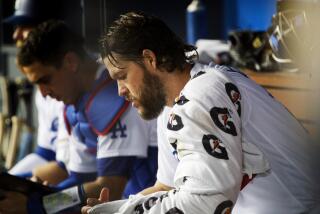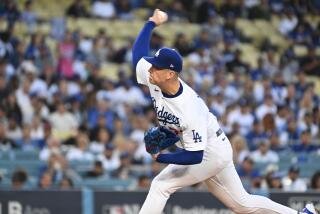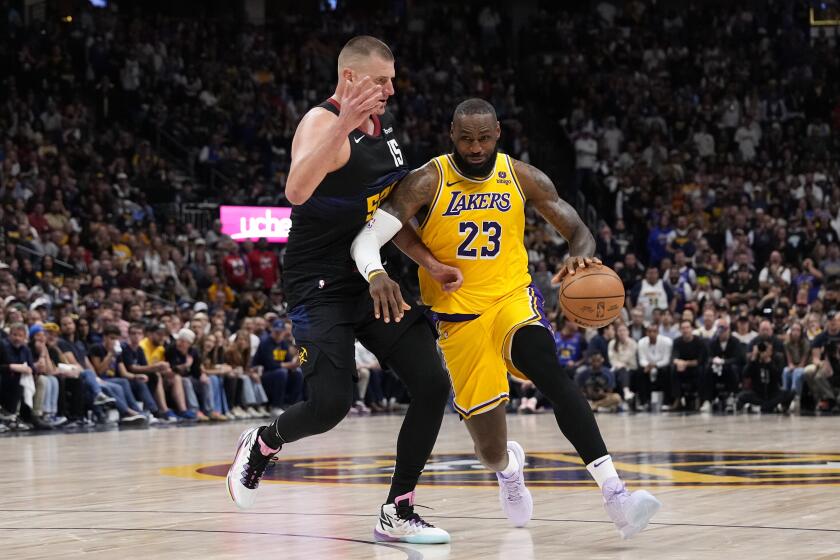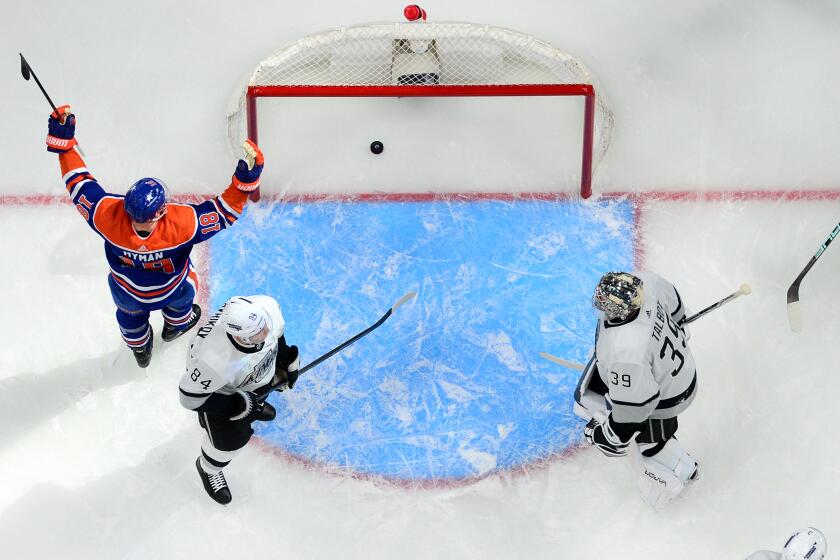Dodgers keeping starting pitchers to short stints isn’t a new formula

Rich Hill will try to save the Dodgers’ season Tuesday, but not with the kind of World Series start that branded Sandy Koufax and Orel Hershiser as heroes in the lore of a storied franchise. The Dodgers no more expect Hill to pitch a complete game than they would expect him to hit a home run.
The Dodgers removed Hill after four innings in Game 2, proactively. He was pitching just fine, but the Dodgers saw danger ahead and decided to get him before he reached it.
Everything old is new again. In the name of Cy Young, how could a team call itself major league and call four innings a quality start?
Dan O’Dowd, come on down.
O’Dowd was the general manager of the Colorado Rockies in 2012, when the Rockies took another crack at the perennial franchise riddle: how can a team pitch effectively when its home is Coors Field?
The Rockies called it “Project 5183,” a mile-high nickname for an experiment in which starting pitchers were limited to about four innings. O’Dowd, now an analyst for MLB Network, said that he saluted Dodgers president of baseball operations Andrew Friedman for his creativity and that, yes, he saw a little bit of his own imagination in what the Dodgers have done this season.
“I think it’s exactly the same thought process,” O’Dowd said.
“It’s clubs trying to look at where the game is going and how to get ahead of the curve. From a competitive standpoint, I think that is exactly what Andrew and his group is attempting and, really, has executed phenomenally well.”

The Dodgers’ starters are not pitching deep into games in October because they have not pitched deep into games all season, by design. They led the National League in earned-run average, but their starters pitched no more than five innings 76 times — essentially, half the time.
Alex Wood, an All-Star, did not make more than 100 pitches in any of his starts. Hill did it twice, in 25 starts. Yu Darvish did it 12 times in 22 starts with the Texas Rangers, then once in nine starts after the Dodgers traded for him.
The data generally show a third time through the lineup can be treacherous for starting pitchers. The Dodgers refreshed their supply of relievers with frequent shuttle service between Dodger Stadium and their triple-A team in Oklahoma City. They enforced rest breaks for their pitchers by manipulating the 10-day disabled list.
“The holy grail of this thing,” O’Dowd said, “is an attempt to keep your guys healthier for a longer period of time.
“I just think clubs are going to have to adapt to this model, in some form or another, based upon where the game has moved.”
This isn’t just about the Dodgers. Pitch counts have become standard operating practice in the major leagues and throughout the minor leagues as well, with the intention of preserving prospects rather than burning them out.
In 1988, the last time the Dodgers had played in the World Series, Hershiser recorded 15 complete games during the regular season, then two complete games in two Series starts. The 2017 Dodgers had two complete games.
“I felt I saw where the game was going,” O’Dowd said, “as it relates to the dearth of starting pitching, the cost of starting pitching, and the evolution of bullpens at the amateur level. I was seeing more and more power arms with a very limited feel for pitching.
“I think that’s going to be the case over the next 10 to 15 years. The evolution of the game is lending itself more towards not giving guys multiple looks within a given game. And, quite honestly, economically, you really don’t have to overspend for starting pitching if you can develop a depth model.”
Translation: Why pay $200 million for Jake Arrieta in free agency, as a seven-inning starter, when you can sign a five-inning starter at a fraction of the cost, then cover the other two innings with a revolving cast of relievers?
I do feel like teams seem to be more willing to go through guys and say, if we burn one out, we have another guy in double A or triple A that throws 97, 98.
— Jeremy Guthrie
To Jeremy Guthrie, a pitcher on that 2012 Rockies team, the evolution intended in part to reduce injuries among starting pitchers might have an unintended consequence: increased injuries among relief pitchers.
“The guy that throws 99 mph, he may or may not be ready for the big leagues,” Guthrie said. “But they’re willing to bring him up, let him learn in the fire, and give him a couple innings. That power arm has proven to play more times than not.
“I do feel like teams seem to be more willing to go through guys and say, if we burn one out, we have another guy in double A or triple A that throws 97, 98. I don’t think it’s a deliberate, hey, we’ll just burn through this guy and, if he gets injured, so what? But, to some extent, when you use bullpen pitchers that often, I think we know the end result is typically going to be: they’re going to need surgery.”
What the Rockies tried five years ago is not exactly what the Dodgers are doing. O’Dowd installed a four-man rotation, with each starter limited to 65 to 75 pitches, and so-called “piggyback starters” used in middle relief.
The Rockies adopted the system in June 2012, then scrapped it before the start of the 2013 season.
“In hindsight, I wish I hadn’t tried it in the middle of the season,” O’Dowd said. “I wish I could have done it as a more of a blueprint in the offseason and rolled into it in the season. Certainly, our situation in Colorado necessitated a lot of different things.”
Said Guthrie: “It didn’t feel like the right answer when I was in the middle of it, but ours was forced by a lot of different issues. Ours was not forced by a lockdown bullpen and the chance to win a game if we were ahead after five. Ours was we feel like pitchers after so many pitches wear down, especially in Colorado, and they get way less effective. We don’t necessarily think the second guy in is better, but he’s a new fresh arm.
“They were creative, but it wasn’t like they entered the season saying they were going to try this. It was more reactionary than it was proactive.”
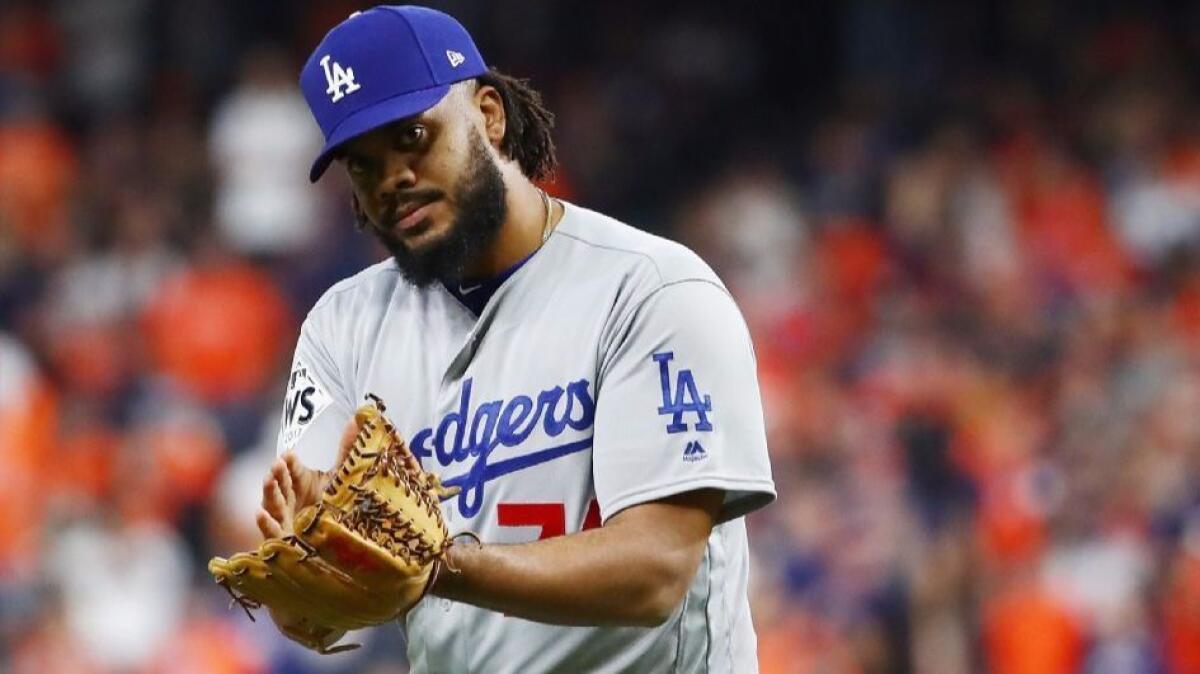
Still, Guthrie said he respected the risk O’Dowd took and the willingness to absorb the criticism that came with it.
“What has made baseball progress is innovative thinking,” Guthrie said. “Those are the types of personalities that make the game great, that make it fun to watch. Those minds are the ones really driving baseball. We’ll see where we end up in five or 10 years.”
And we’ll see where we end up Tuesday.
The relievers for both teams are running on fumes. At the end of three postseason rounds — with no minor league call-ups or 10-day rests on the disabled list — Kenley Jansen, Brandon Morrow and Kenta Maeda looked as helpless and hittable in this year’s Game 5 as Aroldis Chapman and Andrew Miller did in last year’s Game 7.
What the Dodgers could really use Tuesday is a complete game from Hill. That would be something old and something blue.
The Los Angeles Dodgers in the 2017 World Series
Follow Bill Shaikin on Twitter @BillShaikin
More to Read
Get our high school sports newsletter
Prep Rally is devoted to the SoCal high school sports experience, bringing you scores, stories and a behind-the-scenes look at what makes prep sports so popular.
You may occasionally receive promotional content from the Los Angeles Times.

